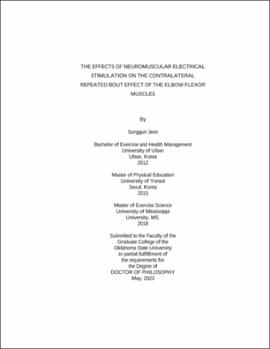| dc.contributor.advisor | Trevino, Michael | |
| dc.contributor.author | Jeon, Sunggun | |
| dc.date.accessioned | 2023-08-30T19:45:09Z | |
| dc.date.available | 2023-08-30T19:45:09Z | |
| dc.date.issued | 2023-05 | |
| dc.identifier.uri | https://hdl.handle.net/11244/339016 | |
| dc.description.abstract | PURPOSE: To examine the effects of neuromuscular electrical stimulation (NMES) on the contralateral repeated bout effect (CL-RBE) of the biceps brachii (BB). METHODS: Twenty untrained adults were randomly assigned into an ipsilateral (IL) or CL group, and completed 7 visits. Following a familiarization (visit 1), participants completed 3 maximal voluntary isometric contractions (MVICs) and submaximal trapezoidal contractions at 40% and 70% MVIC before and after 45 NMES to the BB muscle (1st bout) at pre (visit 2), post (visit 2), 1 day post (24post [visit 3]), and 2 days post (48post [visit 4]). The same procedures were performed for visits 5 (2nd bout), 6 (24post), and 7 (48post) on the same arm for IL or the contralateral arm for CL. Muscle damage markers (MVIC, elbow range of motion [ROM], visual analog scale [VAS] and pressure pain threshold [PPT] for muscle soreness and pain, and muscle thickness via ultrasonography were measured. Surface electromyography (EMG) and mechanomyography (MMG) were recorded from the BB. The EMG signals were decomposed to calculate y-intercepts and slopes for the motor unit (MU) mean firing rate (MFR) and MU action potential amplitude (MUAPAMP) vs. recruitment threshold (RT) relationships. The MMG amplitude (MMGRMS)-force relationships were log-transformed to calculate a and b terms for the linearly varying segments of the trapezoid. EMG amplitude (EMGRMS) and MMGRMS during steady force were normalized (N-EMGRMS, N-MMGRMS) to MVIC. Separate mixed factorial analysis of variance (ANOVAs) were performed. RESULTS: MVIC and ROM at post were less than pre, 24post, and 48post (p<0.05). Muscle thickness at pre was less than post (p<0.001) and 24post (p=0.019). PPT and the b terms at pre were greater (p<0.05) than post, 24post, and 48post. Y-intercepts for the MFR vs. RT relationships during the 70% MVIC were lower at post than pre (p=0.015), 24post (p=0.050), and 48post (p=0.016). VAS were lower (p=0.003) during the second bout (0.21±0.27cm) than the first bout (1.06±0.70cm) for the IL group. There were no significant differences between bouts for other dependent variables. CONCLUSION: Although there was an IL-RBE for VAS, the other variables did not support the existence of IL- or CL-RBE with NMES. | |
| dc.format | application/pdf | |
| dc.language | en_US | |
| dc.rights | Copyright is held by the author who has granted the Oklahoma State University Library the non-exclusive right to share this material in its institutional repository. Contact Digital Library Services at lib-dls@okstate.edu or 405-744-9161 for the permission policy on the use, reproduction or distribution of this material. | |
| dc.title | Effects of neuromuscular electrical stimulation on the contralateral repeated bout effect of the elbow flexor muscles | |
| dc.contributor.committeeMember | DeFreitas, Jason | |
| dc.contributor.committeeMember | Smith, Douglas | |
| dc.contributor.committeeMember | Hausselle, Jerome | |
| osu.filename | Jeon_okstate_0664D_18141.pdf | |
| osu.accesstype | Open Access | |
| dc.type.genre | Dissertation | |
| dc.type.material | Text | |
| dc.subject.keywords | cross education | |
| dc.subject.keywords | electromyography | |
| dc.subject.keywords | motor unit | |
| dc.subject.keywords | muscle damage | |
| dc.subject.keywords | muscle stimulation | |
| dc.subject.keywords | protective effect | |
| thesis.degree.discipline | Health, Leisure and Human Performance | |
| thesis.degree.grantor | Oklahoma State University | |
